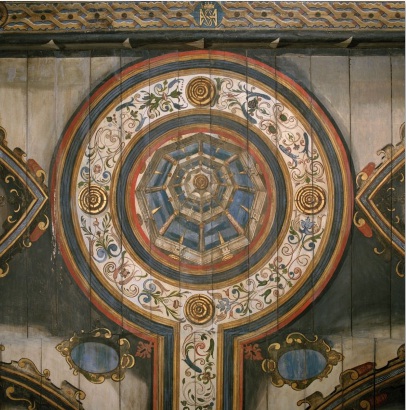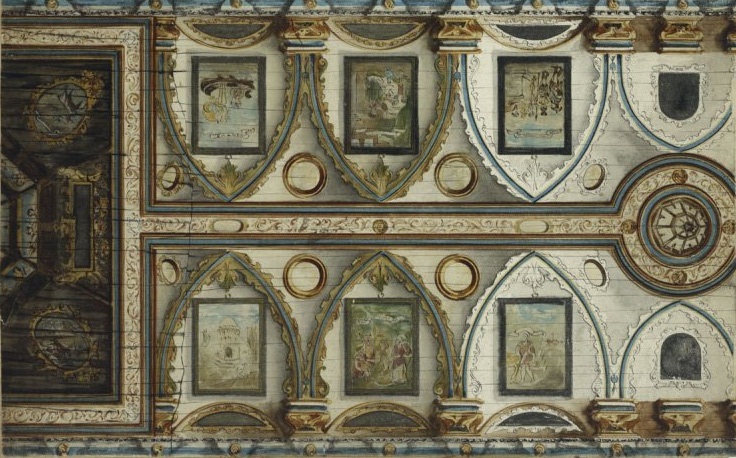 The oldest part of Pinkie
House is the massive central tower erected by the Abbots of Dunfermline, probably
dating from the late fourteenth century. A hundred years later were added the
rooms immediately to the north comprising approximately what is now the
Housemaster’s house. Around 1597 the building came by inheritance into the hands
of Alexander Seton, King James VI’s Chancellor.
The oldest part of Pinkie
House is the massive central tower erected by the Abbots of Dunfermline, probably
dating from the late fourteenth century. A hundred years later were added the
rooms immediately to the north comprising approximately what is now the
Housemaster’s house. Around 1597 the building came by inheritance into the hands
of Alexander Seton, King James VI’s Chancellor.
He was a man of considerable
distinction and was held in such high esteem by the King that when, in 1603, the
latter left for London to add the throne of England to that of Scotland he
entrusted into Seton’s charge and tutelage at Pinkie, his son Charles, later to become King
Charles I.
It has always been assumed that Charles, during his three years’ stay
there, occupied what is still called ‘the King’s Room’.
Seton, after his marriage
to Margaret Hay in 1607, extended the building southwards to include the Long
Gallery with its Painted Ceiling, and the Library and. Drawing Room below it. He
decorated the interior with excellent plaster ceilings and improved the south
wing, now the Headmaster’s house. However, he appears to have been only partially
satisfied with these very considerable extensions for there is a well-known
inscription on one of the walls which states: ‘Alexander, Lord Seton, built this
house in 1613, not as he would have wished, but according to the measure of his
means and estate’.
Pinkie was witness to
several stirring events in Scotland’s history. Located at Pinkie Cleugh between Musselburgh and
Wallyford, the Battle of Pinkie took place on the 10th September, 1547. It was
precipitated by the reneging of a promise by the Scottish Parliament following
the death of King James V in 1542 that the young Mary Queen of Scots could
marry Prince Edward of England. Having given the promise in the Treaty of
Greenwich in 1543, within a year the Scots took the view that a marriage
to the Dauphin of France would give rise to a more strategically valuable
alliance.
Thus King Henry VIII directed the English army, under the Duke of
Somerset, to begin a campaign known as the 'Rough Wooing' which involved
incursions into Scotland in 1544 and 1545. Henry died in January 1547 and
Somerset, now Protector or guardian of the young King Edward VI, attacked
again in 1547.
The much larger, but less disciplined, Scottish army under the indecisive
James Hamilton, 2nd Earl of Arran (1516-75), was caught between the English
army and cannon-fire from the English fleet lying offshore. More than half of
the Scottish army were killed or injured. While the Scots suffered a serious
defeat, the English lost out too because the battle simply sped the marriage
between Mary and the Dauphin and the alliance with France.
 In 1567, twenty years after the
disastrous Battle of Pinkie, when it was said that the Pinkie Burn ran with blood
for three whole days, the Confederate Lords of Scotland took prisoner their
sovereign, Mary Queen of Scots, at Carberry Hill, only two miles away to the
south-east, before imprisoning her at Loch Leven and then banishing her to
England. In 1650 the troops of Cromwell were encamped on the Links at Musselburgh,
where they remained for nearly two months before withdrawing to Dunbar to inflict
another defeat on the Scots.
In 1567, twenty years after the
disastrous Battle of Pinkie, when it was said that the Pinkie Burn ran with blood
for three whole days, the Confederate Lords of Scotland took prisoner their
sovereign, Mary Queen of Scots, at Carberry Hill, only two miles away to the
south-east, before imprisoning her at Loch Leven and then banishing her to
England. In 1650 the troops of Cromwell were encamped on the Links at Musselburgh,
where they remained for nearly two months before withdrawing to Dunbar to inflict
another defeat on the Scots.
But the highlight must have been in 1745 when,
following the Battle of Prestonpans, the Long Gallery was used as a casualty
station (the bloodstains from the wounded are still visible) and Prince Charlie
spent two nights in the King’s Room before setting out on his journey to receive
the acclamation of the citizens of Edinburgh.
Pinkie passed to Seton’s
grandson, Sir John Hay, later 1st Marquess of Tweeddale, and remained in that
family until 1788, when it was acquired by Sir Archibald Hope, 9th Baronet of
Craighall, in Fife.
The latter’s son, Sir John, in about 1826 enlarged the
policies and added the portico entrance on the west side of the house and the
broad open stairway behind it where his portrait now hangs.
He also reconstructed
the south wing, adding a new façade on its north wall and the two-storeyed bow
window on the south.
The Hope family continued to own Pinkie
until the then Baronet, another Sir Archibald Hope, sold it to Loretto in 1951,
since when it has become an intrinsic part of the School.
